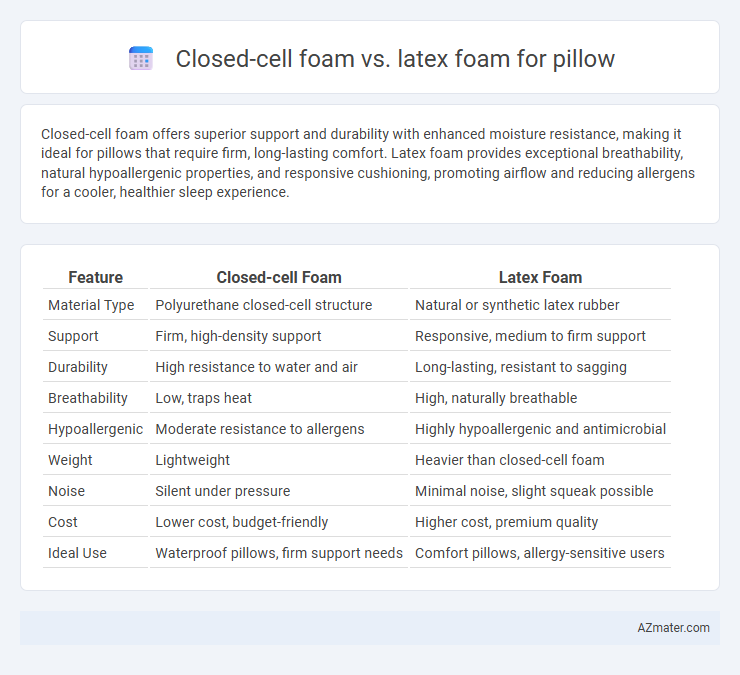Closed-cell foam offers superior support and durability with enhanced moisture resistance, making it ideal for pillows that require firm, long-lasting comfort. Latex foam provides exceptional breathability, natural hypoallergenic properties, and responsive cushioning, promoting airflow and reducing allergens for a cooler, healthier sleep experience.
Table of Comparison
| Feature | Closed-cell Foam | Latex Foam |
|---|---|---|
| Material Type | Polyurethane closed-cell structure | Natural or synthetic latex rubber |
| Support | Firm, high-density support | Responsive, medium to firm support |
| Durability | High resistance to water and air | Long-lasting, resistant to sagging |
| Breathability | Low, traps heat | High, naturally breathable |
| Hypoallergenic | Moderate resistance to allergens | Highly hypoallergenic and antimicrobial |
| Weight | Lightweight | Heavier than closed-cell foam |
| Noise | Silent under pressure | Minimal noise, slight squeak possible |
| Cost | Lower cost, budget-friendly | Higher cost, premium quality |
| Ideal Use | Waterproof pillows, firm support needs | Comfort pillows, allergy-sensitive users |
Introduction to Foam Pillows
Closed-cell foam offers firm support with enhanced durability and resistance to moisture, making it ideal for pillows that require structural integrity and longevity. Latex foam provides a naturally resilient and breathable option, delivering pressure relief and hypoallergenic properties suited for sensitive sleepers. Both foam types contribute distinct comfort and ergonomic benefits, influencing pillow performance and user experience.
What Is Closed-Cell Foam?
Closed-cell foam is a dense, durable material characterized by tightly packed foam cells that create an impermeable barrier, preventing air and moisture from passing through. This structure provides excellent support and resilience, making it ideal for pillows that require firmness and long-term shape retention. Unlike latex foam, which is naturally breathable and flexible, closed-cell foam offers superior water resistance and enhanced durability for specific comfort needs.
What Is Latex Foam?
Latex foam is a durable, natural material derived from the sap of rubber trees, prized for its resilience and breathability in pillows. Unlike closed-cell foam, latex foam features an open-cell structure that promotes excellent airflow, enhancing temperature regulation and comfort during sleep. This natural elasticity provides consistent support while reducing pressure points, making latex foam an ideal choice for ergonomic pillows.
Comfort and Support Comparison
Closed-cell foam offers firm support with its dense structure, maintaining shape under pressure and providing consistent spinal alignment. Latex foam excels in comfort due to its natural elasticity and breathability, contouring to body curves while promoting airflow to reduce heat buildup. Both materials balance support and comfort differently, with closed-cell foam favoring durability and latex foam emphasizing pressure relief and responsiveness.
Durability and Longevity
Closed-cell foam offers superior durability and maintains its shape longer due to its dense, impermeable structure, resisting wear and sagging over time. Latex foam, especially natural latex, provides excellent resilience and longevity with inherent antimicrobial properties that prevent degradation. Both materials support extended pillow life, but closed-cell foam typically outperforms latex foam in moisture resistance and structural stability.
Breathability and Temperature Regulation
Closed-cell foam features a dense structure that limits airflow, resulting in lower breathability and potential heat retention during sleep. Latex foam, by contrast, has an open-cell architecture with natural ventilation channels that promote superior breathability and enhanced temperature regulation. This makes latex foam pillows more effective at dissipating heat and maintaining a cooler sleep surface compared to closed-cell foam.
Hypoallergenic and Health Considerations
Closed-cell foam pillows offer superior resistance to allergens such as dust mites and mold due to their dense, impermeable structure, making them ideal for individuals with asthma or severe allergies. Latex foam pillows, especially those made from natural latex, provide natural antimicrobial and antifungal properties, reducing the risk of mold growth while also being biodegradable and eco-friendly. Both materials are hypoallergenic but closed-cell foam is often more effective in preventing allergen penetration, whereas latex foam promotes better breathability and moisture control, supporting overall respiratory health.
Environmental Impact
Closed-cell foam pillows, often made from polyurethane, have a higher environmental footprint due to non-biodegradability and reliance on petroleum-based materials, contributing to landfill waste and toxic chemical emissions during production. Latex foam pillows, especially those made from natural latex sourced from rubber trees, offer a more sustainable option with biodegradability and renewable harvesting practices that reduce ecological harm. However, synthetic latex variants still pose environmental challenges similar to closed-cell foam, emphasizing the importance of choosing natural latex for an eco-friendlier pillow.
Price and Value Analysis
Closed-cell foam pillows generally offer a lower price point compared to latex foam pillows, making them a budget-friendly choice for many consumers. While closed-cell foam provides firm support and durability, latex foam, especially natural latex, delivers superior comfort, breathability, and hypoallergenic properties, enhancing long-term value despite its higher cost. Evaluating initial cost against longevity and health benefits, latex foam pillows often represent a better investment for those seeking balance between price and quality.
Which Pillow Foam Is Right for You?
Closed-cell foam pillows offer firm support and excellent durability, making them ideal for side sleepers seeking spinal alignment, while latex foam pillows provide a responsive, breathable surface with natural hypoallergenic properties, perfect for those prone to allergies or who prefer a bouncier feel. Understanding your sleep position, allergy sensitivities, and desired firmness will help determine if closed-cell foam's dense structure or latex foam's elasticity suits your comfort needs best. Choosing between these foams depends on prioritizing either support longevity and firmness or ventilation and natural material benefits.

Infographic: Closed-cell foam vs Latex foam for Pillow
 azmater.com
azmater.com